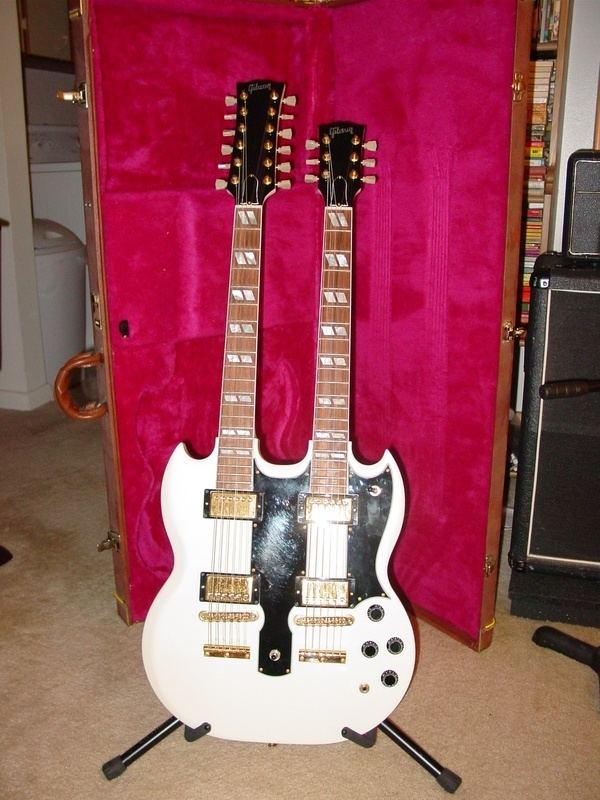Manufacturer Gibson Neck joint Set (Twin) | Body type Solid Body Mahogany | |
 | ||
Period 1963–1968, 1974–1998, 1998–present Neck Mahogany (vintage) or Maple (today) | ||
The Gibson EDS-1275 is a doubleneck Gibson electric guitar, weighing about 13 pounds (5.9 kg) and introduced in 1958. Popularized by both rock and jazz musicians such as Don Felder, Jimmy Page, Alex Lifeson and John McLaughlin, it was named "the coolest guitar in rock" by the website Gigwise, and is still produced today.
Contents
History
Gibson's first double neck guitars were produced from 1958 to 1961 with a hollow body and two 6-string necks, one being a short-scale neck tuned to a higher octave; from 1962 to 1967 it had a solid body. A model with a 4-string bass and a 6-string guitar neck was called the EBS-1250; it had a built-in fuzztone and was produced from 1962 to 1968 and again from 1977 to 1978.
In 1963, the solid-body EDS-1275 was designed, resembling the SG model; this version of the doubleneck was available until 1968. The EDS-1275 is often referred to as the "SG double neck" due to its similar shape, although both necks of the 1275 have a shorter scale fret board than the SG and fixed tail pieces, where the SG has an adjustable one. The guitar was available in jet black, cherry, sunburst, and white.
In 1974, Gibson started making the guitar again, in a number of additional colors, with production lasting until 1998. Since then, alpine white and heritage cherry versions were made by Gibson USA in Nashville, Tennessee, until 2003, in the Nashville Custom Shop from 2004 to 2005, and in the Memphis, Tennessee, Custom Shop beginning in 2006.
Popularity
The EDS-1275, while never selling in great quantities, was used by a number of notable musicians. Chicago bluesman Earl Hooker is seen holding one on the cover of the 1969 albums Two Bugs and a Roach and The Moon is Rising, and Elvis Presley sports a cherry doubleneck in the 1966 movie Spinout.
Jimmy Page
The model was popularized by Jimmy Page of Led Zeppelin, most notably during live performances of "Stairway to Heaven." The doubleneck obviated the need to switch guitars mid-song: at the beginning of "Stairway to Heaven", he used the bottom 6-string neck for the intro and first verse, then switched to the top 12-string neck, then to the 6-string neck for the extended guitar solo, and back to the 12-string for the final chorus.
By the time Page desired an EDS-1275, they were no longer in production so he ordered a custom-made cherry 6/12. Page's EDS-1275 has a slightly different body shape from that of the current model. Page's also has one-piece mahogany necks rather than the current three-piece maple, and has tailpieces positioned near the bottom of the body, reportedly increasing sustain, and Patent No. or T-Top humbucking pickups.
Page's influence was such that after him other guitarists picked up the EDS-1275, including Alex Lifeson of Rush, who used it to play the song "Xanadu" live. Eddie Van Halen also has one in his collection.
Jimmy Page signature model
Gibson released a VOS (Vintage Original Spec) Jimmy Page Signature EDS-1275 model in 2007; a total of 250 were made. Page kept serial number one for himself. Serial numbers 2 through 26 of these were played and signed by Page; number 11 was donated for auction to benefit a charitable cause.
John McLaughlin
In the early 1970s, jazz-rock musician John McLaughlin played an EDS-1275 in his first years with the Mahavishnu Orchestra; the guitar, amplified through a 100-watt Marshall amplifier "in meltdown mode," produced the signature McLaughlin sound hailed by Guitar Player as one of the "50 Greatest Tones of All Time."
Alex Lifeson
Alex first bought a cherry 1976 EDS-1275, in Nashville at the end of the 2112 tour. It was modified with an after market tune-o-matic bridge on the six string, and an especially designed bridge for the twelve string for intonation. In 1978, during the 'Hemispheres' tour, the guitar was broken when a speaker horn fell on it, in Uniondale, New York. Gibson later repaired it and repainted it Alpine White; he continued to use it until the 'Signals' Tour (1982–1983) when it was retired. It saw use again on the 'Counterparts' Tour in 1994, where it was used to play 'Cygnus X-1 Book II: Hemispheres (Prelude)'. In 1996 Alex gave his EDS-1275 to Gordie Johnson of Big Sugar, which Gordie used in the music video of the single Diggin' a Hole.
Steve Clark
Steve Clark of Def Leppard signed an endorsement with Gibson in the mid-1980s and used two EDS 1275s on the Hysteria World Tour in 1987/88.
Current model
The guitar is currently offered only through the Gibson Custom Shop as a special order model. It features two volume and two tone control knobs, a three-way pickup-selector switch, and a three-way neck-selector switch. It has vintage tulip tuners, pearloid split parallelogram inlays, black pickguards and pickup rings, twenty frets per neck (bound with single-ply white binding), and 490 Alnico (R) and 498 Alnico (T) humbucking pickups. The Custom Shop also makes a Don Felder "Hotel California" signature model.
Epiphone
Epiphone (a Gibson subsidiary) makes a version of the classic doubleneck, marketing it as the G-1275.
Ibanez
Japanese guitar manufacturer Ibanez produced a model inspired by the Gibson, called the Double Axe, from 1974 to 1976. They were available as a 6/12, a 4/6, and a 6/6 configuration, in cherry and walnut finishes.
In popular culture
The Gibson EDS-1275 in both finishes Cherry, which resemble Jimmy Page's, and Alpine White with gold hardware appeared in video games Guitar Hero and Guitar hero II as purchasable guitars. The doubleneck resembling Don Felder's appeared in Guitar Hero: Aerosmith as an unlockable guitar for getting 5-stars in every career song on Hard.
